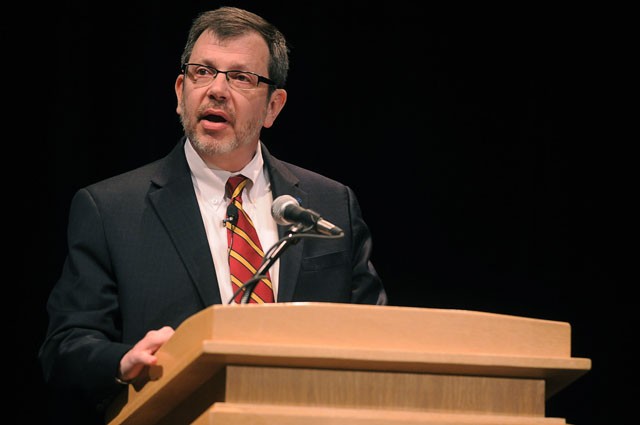The University of Minnesota Board of Regents has named Stony Brook University Provost Eric Kaler as the sole candidate to replace Bob Bruininks as the University’s 16th president.
Four semi-finalists, whose names had been kept private, were forwarded to the board last week for consideration as finalists. The board did not discuss two candidates who didnâÄôt wish to be considered publicly among a pool of finalists and withdrew to avoid having their names made public.
Of the two remaining candidates, the board chose to invite only one, Kaler, to campus for interviews.
Kaler, who received a chemical engineering Ph.D. from the University in 1982, will make public appearances on campus next Wednesday and Thursday, and Regents Chair Clyde Allen said if all goes well, the board could be ready to take action on the appointment next week.
âÄúItâÄôs entirely possible,âÄù Allen said. But the selection of only one finalist does not mean the process is over, and the regents could return to the other candidates if theyâÄôre not satisfied with Kaler, Allen said.
Kaler watched his approval as a finalist from his office in Stony Brook.
âÄúI watched it on the web,âÄù he said. âÄúSo I knew instantaneously.”
If chosen, Kaler said his goal would be to make the University a national destination for students.
He was contacted by the UniversityâÄôs search consultant firm in August, and said his strong ties to the University from his days as a student were a big reason he applied.
âÄúIt was an enormously transformative place for me as a graduate student,âÄù he said. âÄúWhen you lay that against the fact that itâÄôs really one of the best institutions of public higher education in the country, it was very, very attractive.âÄù
As Stony BrookâÄôs provost, a position heâÄôs held since 2007, Kaler helped lead the school through economic difficulties and budget cuts similar to those faced by the University of Minnesota.
The New York school responded to these challenges by cutting instructional staff, using space more efficiently and increasing student enrollment, especially in the graduate school, he said.
Although Stony Brook is smaller than the University of Minnesota âÄì it has roughly half the students âÄì Kaler said his leadership style would stay the same as president.
âÄúIâÄôm a consultative kind of guy,âÄù he said. âÄúI anticipate involving students and faculty and staff in decision making.âÄù
Before working at Stony Brook, Kaler was a professor and dean of the College of Engineering at the University of Delaware.
Michael Chajes, current dean of the College of Engineering at the University of Delaware, described Kaler as âÄúa highly accomplished administrator and a highly accomplished researcher.âÄù
While serving as dean of the College of Engineering, Kaler helped grow the schoolâÄôs enrollment and research efforts while working on a tight budget, Chajes said.
Chajes said Kaler was a decisive leader who dealt with inquiries and issues quickly.
âÄúHeâÄôs very good at analyzing the situation, hearing all sides of it and then fairly quickly and decisively being able to make a good decision,âÄù Chajes said. âÄúHe didnâÄôt let things sit for very long.âÄù
Kaler already knew about many of the issues facing Stony Brook when he started as provost and worked quickly to address them, said Robert Kelly, a professor at Stony Brook.
âÄúHe is very decisive and get things done,âÄù Kelly said of Kaler. âÄúBut he gets things done in a way that gets the buy-in of everybody involved.âÄù
Although Stony BrookâÄôs administration, including Kaler, had to deal with serious budget cuts over the past few years, Kelly said administrators dealt with the cuts while still protecting academics.
One of KalerâÄôs strengths, Kelly said, was connecting research to funding opportunities.
âÄúHe really knew who exactly to approach and how to make sure that there was a good supply of funding,âÄù Kelly said.
At Stony Brook, Kaler oversaw Brookhaven National Laboratory, a Department of Energy-funded laboratory that employs 3,000 researchers in areas like biotechnology, material science, nuclear physics and high-energy physics.
Research is a critical component of a large school like the University of Minnesota, Kaler said,
âÄúThe University of Minnesota is first and foremost a research institution in my view,âÄù he said. âÄúWe have to be excellent in delivering the research mission.âÄù
A continuing process
On Wednesday afternoon, Kaler will participate in a public comment and question session at Coffman Union that will be streamed online.
Kaler will also meet with various groups like the student government, the Faculty Consultative Committee and various deans and administrators during his visit.
The Board of Regents will hold an hour-long public interview with Kaler on Thursday morning at McNamara Alumni Center.
FridayâÄôs meeting was the first time the full board gathered to discuss the candidates, and for much of the discussion members referred to candidates by letter designations to protect their privacy.
Regent Dean Johnson said he had some reservations about naming only one candidate and acknowledged some criticism could be leveled at the University because of the process.
The announcement comes after a five-month search process where a 12-person search advisory committee considered 148 applications.
Allen said the search included a diverse pool of applicants, including 44 women and at least 12 minority candidates.
Johnson said Kaler has a strong resume and is a solid candidate on paper, but the interviews are needed to determine if the candidate is a good fit to lead the University.
Regent John Frobenius said he was impressed with KalerâÄôs range of his experiences and his ability to make decisions while working and communicating with different constituency.
All four of the semi-finalists were external candidates with strong administrative backgrounds, Allen said. All had previous Big Ten experience as either professors, administrators or âÄì in KalerâÄôs case âÄì as a student.
If appointed, Kaler would be the second University alumnus to lead the school as president. The first was Malcolm Moos, who was president from 1964 until 1974.


